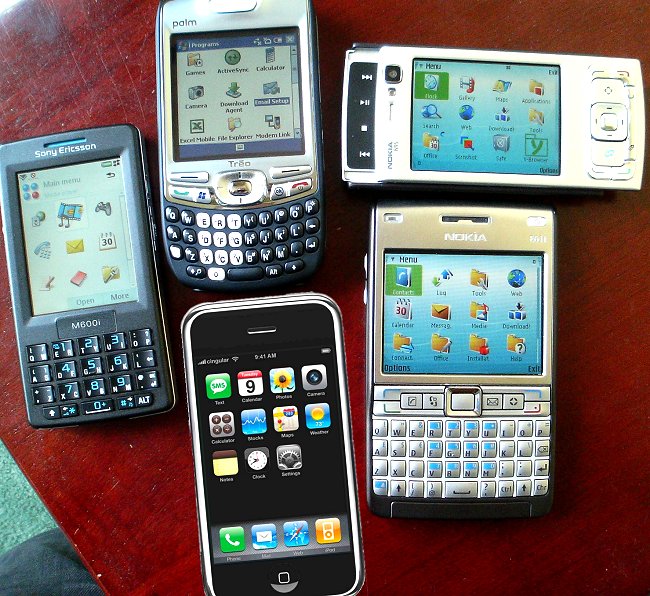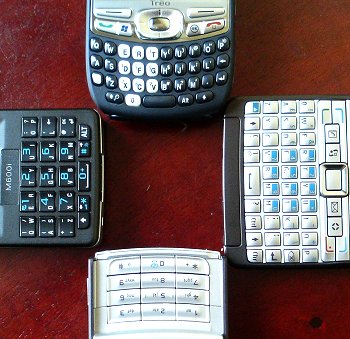Apple themselves are still drawing direct comparisons, curiously, as in this press release. In concentrating mainly on battery life, Apple doesn't really show the whole picture, of course, but then it was PR promoting the fact that the iPhone's battery will last longer than they initially thought it would, which is fair enough...
But let's look at the iPhone from the point of view of Jobs' talk, i.e. aimed at replacing existing smartphones. (though personally I think it will do better in the iPod upgrading market). I'm comparing the iPhone with the Nokia E61i and N95, the Sony Ericsson M600i and the Palm Treo 750:

OK, ok, it's a fair cop. I haven't actually got an iPhone yet, but I'm close (see below).... which explains the one mock-up device image above 8-)
My reasons for choosing these devices:
The E61i: Jobs showed the E62 up on his iPhone launch screen, the USA variant, but I'm in Europe and so have the (more function-rich) E61i!
The M600i: Although not in Jobs' line-up, this has very much the same emphasis as the Treo 750, E61i, etc. and adds a touchscreen, bringing it more into Apple's way of thinking.
The N95: Not on Jobs' launch screen, but very much on his 'radar', I suspect, this multimedia-centric smartphone directly appeals to a lot of the iPod/iPhone demographic.
The Treo 750: This was on Jobs' screen, albeit probably in a USA version.
Apple iPhone | Nokia E61i | Sony Ericsson M600i | Nokia N95 | Treo 750 | |
| Form factor | Tablet, 3.5" touchscreen, one physical button | Robust tablet, 2.8" screen, 50 buttons | Tablet, 2.5" touchscreen, 23 buttons | Robust slider phone, 2.8" screen, 25 buttons | Tablet, 2.4" touchscreen, around 50 buttons |
| Unlocked, SIM-free price (before sales tax) | Unknown, probably around $900 (£500) | £255 | £170 | £425 | £340 |
| Runs | Version of OS X | S60 3rd Edition on Symbian OS | UIQ 3 on Symbian OS | S60 3rd Edition, Feature Pack 1, on Symbian OS | Windows Mobile 5 (free upgrade to WinMob 6 soon) |
| Battery life | Good, but integral, non-removable battery | Excellent, plus battery can be removed | Good, plus battery can be removed | Low, though battery can be removed | Average, battery can be removed |
| Apps, text entry | A restricted application set, but graphical and intuitive. Text entry via fingers using an on-screen keyboard. Word completion software helps. | The largest set of applications here, from PIM to Office document editing to multimedia, though not all are trivial to use or optimised for the qwerty keyboard. Text entry very fast in all apps. | A good set of applications, centred around PIM and messaging, but including Office document editing. Text entry probably fastest with the two-way keys, but stylus entry with an on-screen keyboard and with Jot gesture recognition is also possible. Word completion software also helps. | The usual S60 glut of apps and mini-apps, with something of a media/online bent. With no touchscreen or keyboard, text entry is inconvenient, using predictive text on the keypad, and impossible when the N95 is in 'landscape' mode (although a separate Bluetooth keyboard would get round this) | The full Windows Mobile application set, including Office document editing, with touch-screen support. Not as comprehensive as on the E61i, but not far off. Text entry is via the good but cramped qwerty keyboard. |
| Imaging | 2mp camera, QVGA video (probably) | 2mp camera, CIF video | None | 5mp camera, VGA video | 1.3mp camera, QCIF video |
| Music and expansion | Very slick, as you'd expect, and with browsable cover art, MP3 and AAC formats supported. 4GB or 8GB capacities. | Only ships with a mono headset. Plays stereo with right accessory, albeit clumsily, MP3 and AAC formats supported. Expandable to 2GB. | Slightly clumsy, MP3 and AAC formats supported. Expandable to 4GB. A2DP (Bluetooth stereo) supported. | Very slick, with dedicated hardware controls, although cover art is hit and miss. MP3, AAC and WMA formats supported. Expandable to 4GB. A2DP supported. | Slightly clumsy, but MP3, AAC and WMA formats are supported. Expandable to 2GB. A2DP supported. |
| Durability, real world experience | Pouched/cased by necessity, to protect the touch-screen from damage. In use, requires two hands to use at all times. | Metal construction, simple design and toughened screen make this very durable. Can be used one-handed but two are required for serious text entry. | Usually cased, despite the heavy bevel to the touch-screen, it's still vulnerable. Text entry is easy enough one-handed, but many touch-screen operations require two. | Not quite as durable as you might think, with 'soft' display that needs protecting (especially in view of the value of the device) and a flexible ribbon connection between top and base unit. Almost all operations are easy to accomplish one-handed. | As with the M600i, a Treo is usually cased, with the touch-screen still vulnerable. Text entry is acceptable one-handed, but serious entry and many touch-screen operations require two. |
| Connectivity | EDGE, otherwise GPRS. Plus Wi-Fi, where available | GPRS, EDGE, 3G, plus Wi-Fi where available | GPRS, 3G | GPRS, EDGE, 3G, HSDPA, plus Wi-Fi where available | GPRS, EDGE, 3G, HSDPA |
| Extra applications | Extensible using Widgets and Web applications in the web browser | 800 native S60 applications and games, plus 1000 more Java apps and Widgets | Several hundred native UIQ applications and games, plus 1000 more Java apps. | 800 native S60 applications and games, plus 1000 more Java apps and Widgets | Up to a thousand Windows Mobile apps, plus Java, although not all of these are 100% compatible. |
Apple iPhone | Nokia E61i | Sony Ericsson M600i | Nokia N95 | Treo 750 |
Several things leap out from this comparison, of course:
- Obviously, the only sense in which the iPhone can claim to be way ahead of the competition is in its simplified Graphical User Interface (GUI). In terms of hardware specs, it's average at best. This emphasis on the GUI makes a lot of sense, it's true, especially for smartphone-newbies upgrading from the iPod, for example. However...
- ... it's also evident that there's a real choice to be made in how you use your phone/media player/communicator, i.e. whether you're happy to use two hands all the time, whether you'd like a mix of one-handed and two-handed use, or whether you prefer one-handed all the time. If this sounds trivial, just think about using your smartphone while carrying a briefcase or purse, or hanging from a tube train rail, or holding your child's hand, or pushing a pushchair. These sorts of scenario should make you think about where and when you'll be wanting to take and make calls, send messages, use the Internet, etc.
- There are huge price differences between the different devices, with the unsubsidised iPhone (as and when this becomes available) likely to be three or four times the price of the Sony Ericsson M600i, for example. This latter, along with the E61i, are looking like pretty good value as smartphones that can be used on any network and with any SIM card.
- Third party software will play a huge part in what can be done with each device. Web applications for the iPhone make a lot of sense and I'm sure will be quite numerous, but they'll by nature be Widget-like and relatively limited. Serious applications (and seriously good games) are only possible with native code, as allowed on S60, UIQ and Windows Mobile, above. Again, I doubt this factor will be considered at the point of purchase by the typical iPhone buyer, but with hindsight it's certainly important to me.
Incidentally, I will be getting (with my Smartphones Show hat on) an Apple iPhone, for test purposes, in the first few weeks of July, and it will be interesting to see the much-hyped new GUI in action for myself.
Steve Litchfield, 19 June 2007

Touchscreen good, keyboards bad?
No, no, no, there's a lot more to smartphone design than that - those keyboards are there for a good reason!
